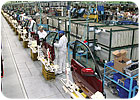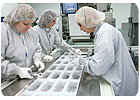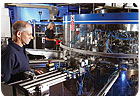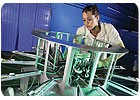To get the most out of a benchmarking visit, you’ll have to do more than just knock on your competition’s door.

Benchmarking is a method of comparing your product or process with someone else’s. This can be your competition, a noncompeting company or a different organization in your own company.
Benchmarking can be used to obtain information before you develop your manufacturing process or to gauge the performance of an existing process. Benchmarking doesn’t have to be limited to a manufacturing process. It can be used to collect information about other processes, such as just-in-time parts delivery.
The goal of benchmarking is to get the most information, in the most organized manner, in the shortest amount of time.
During a benchmarking visit, you can find out:
* What processes are used to assemble a particular product?
* What equipment is used?
* What is the cycle time of each step?
* What is the level of automation?
* What settings-such as temperature, pressure or feed rate-are used for specific processes?
* What tools, fixtures and gauges are used?
* What is the scrap rate and what are the reasons for scrap?
* What methods are used to control various process steps?
* Does the host company inspect 100 percent of incoming parts, or does it rely on his supplier’s controls?

You can benchmark your competition, a noncompeting company or even a different organization in your own company. Photo courtesy MEDRAD
The Ultimate Challenge
The most difficult benchmarking project to accomplish is, of course, a visit to your direct competition. It will be difficult to make contact and get your competition to agree to a visit. However, the climate for mutual benchmarking has improved dramatically. At one time, engineers from Ford could never visit a GM facility and vice versa. Today, it’s not out of the question. Your competition may be willing to accept it if it’s a reciprocal agreement-I’ll show you my line if you show me yours.Before you contact the company you want to benchmark, you’ll need approval from your own management team. Some managers don’t care what the competition is doing. Others don’t want the competition snooping around their own facilities.
Once you get the green light, you can contact facilities to benchmark. There is no golden rule for how to contact your competition. You have to rely on initiative and innovation. Ask people who used to work for the competition and now work in your organization. Ask people in your purchasing or marketing department if they have contact information, or ask your management team.
If you’re lucky enough to be invited for a visit, you’ll need to put together a benchmarking team. The most effective team consists of four members: an interviewer, a note-taker, a roamer and an industrial engineer.
The interviewer should be a manufacturing engineer, preferably one who knows the process you want to know about. If it’s a new process, you’ll want to recruit your most experienced engineer. The note-taker could be another manufacturing engineer. By taking notes, this team member enables the interviewer to concentrate on learning about the process.
The roamer should have some manufacturing experience. He will be roaming “free” to look for scrap parts-not to criticize the host, but to establish a true picture of the operation. The roamer writes down names of machine builders, model numbers and serial numbers, and he collects information from bulletin boards on various issues, such as throughput and quality indicators. He also counts the number of employees on the floor.
The industrial engineer’s job is to do a discrete time study. Your host knows that he is going to do a time study, so there is no reason to hide it.
Some responsibilities should overlap deliberately to double-check the information collected during the visit.
An additional team member can be included. This could be a product engineer, buyer, department manager, production supervisor or another manufacturing engineer. The extra person can make sketches of the product, assembly line and overall layout of the plant, noting the number of operators and writing down the sequence of operations.
If you can’t afford to send four people, take three. One person can serve as both the roamer and the industrial engineer. Can you benchmark using one person? Certainly. However, one person will be unable to do everything that a four-member team could.

When organizing a benchmarking trip, it’s a good idea to maintain a single point of contact at each facility. Too many contacts will only cause confusion. Photo courtesy MK Electric Ltd.
You're In! Now What?
When organizing a benchmarking trip, it’s a good idea to maintain a single point of contact at each facility. Too many contacts will only cause confusion. The contact person at your organization should be the team member who’s serving as the interviewer.Once you get approval, develop a schedule. Notify your host and your team about your travel arrangements. Invite engineers from your host for dinner before the visit. This is a great opportunity to talk informally about business. Don’t take notes during dinner! Talk about the market, your products, employment, problems and solutions, cooperation with other companies, R&D, expansion plans and industry rumors. The more information you get during dinner, the more time you will have to focus on the nitty-gritty during the plant tour. Afterwards, sit down with the whole team and take notes about what you just found out.
Before you knock on your host’s door, establish a goal for your benchmarking visit. What are you trying to find out? What is important to you? Is it a specific process or line design? Or a goal for cycle time or efficiency? Once you know that, write down a list of questions and submit them to your host prior to the visit.
Here’s a typical turn of events on a benchmarking visit:
* Introduction and exchange of business cards.
* Host’s presentation, including company profile, product review, sales figures and growth predictions.
* Question-and-answer session. Now’s the time to ask those questions you submitted ahead of time.
* “Wide aisle” tour, a quick overall plant tour.
* “The process” tour, the crux of the tour.
* Question-and-answer session and wrap-up.
During the tours, you’ll want to note the number of operators, cycle times, number of stations, types of machines, and the number of components. Sketch the tooling, line layouts, station layouts, and the sequence of loading parts. When sketching machines and tooling, be specific enough that your toolmaker can design a similar device based on your drawing.
Audio recorders, video cameras and photographic cameras are invaluable for benchmarking, but it’s highly unlikely your host will permit their use. Still, it never hurts to ask. Keep in mind that if your host allows you to photograph or videotape his process, you will have to allow him to do the same during his reciprocal visit.
Videotapes produce the best reference material that you can show and share. However, video does not obviate the need to take notes and make sketches. That’s because your notes are the best source of information, and they are the easiest way to quickly find what you want. If you rely strictly on video, you will be viewing the tape for hours and days, forward and backward, trying to take notes after the fact. The ideal is to have both a videotape and notes. That way, you can write your report based on your notes and use the tape to prove your points and check for details that you might have missed. One more advantage of using a video camera is its ability to record sound. As you shoot the process, talk to your camera: note how many operators are present or how long it takes to make a tool change.
Photographs are helpful, too, but again, they do not obviate the need for sketches. When you sketch a part or a machine component, you are more likely to notice an odd shape or feature. And if you notice such an irregularity on the shop floor, you can ask about it right then. If you discover the feature back in your office, you may never learn what it was for.
Incidentally, your host is more likely to grant permission to use a Polaroid camera than an SLR camera. That’s because Polaroid pictures are difficult to reproduce, and they are typically of lesser quality than photos produced by other cameras.
During your visit, don’t forget to observe the “human” element of your competition. That’s what makes your competition strong. Look for signs of how hourly folks are contributing to quality-not what the managers tell you during their presentation, but the true signs of what is really happening on the floor.
It’s critical to be well-organized and efficient on your visit, because the competition will surely be when they visit your floor. Your host will expect you to take advantage of every opportunity to get the most out of the visit. If you are not well-organized, you are wasting his time as well as yours.
It’s not a bad idea to ask for samples, such as parts, subassemblies and the final assembly. You may not get them, but it’s worth a try. Of course, if your host gives you samples, you will have to provide samples of your own in return.

After a benchmarking visit, debriefing should be done as soon as possible. Photo courtesy Power Panels Electrical Systems Ltd.
The Final Step
Debriefing should be done as soon as possible after you leave the facility. If you don’t debrief right away, you will lose a lot of valuable information. Compare notes and put them together in a rough draft of a report.
Depending on the objective of the visit, the final report should include the following information:
* Company information, including number of employees, and sales for the past, current and projected years.
* Number of manufacturing and design engineers.
* Quality control procedures.
* Products assembled at the plant, including parts made in-house and parts that are purchased.
* Step-by-step description of the assembly process, including the number of operators and the amount and frequency of changeovers.
If your benchmark report doesn’t include an action plan, conclusion and recommendations, your tour was just a nice trip, nothing more.
Editor’s note: Raven Engineering is a consulting firm and the manufacturer of the Super Cell, a workstation with a built-in rotary indexing table. For more information, call 812-320-3382, e-mail stangarus@yahoo.com, or visit http://sgarus.home.insightbb.com.
Depending on the objective of the visit, the final report should include the following information:
* Company information, including number of employees, and sales for the past, current and projected years.
* Number of manufacturing and design engineers.
* Quality control procedures.
* Products assembled at the plant, including parts made in-house and parts that are purchased.
* Step-by-step description of the assembly process, including the number of operators and the amount and frequency of changeovers.
If your benchmark report doesn’t include an action plan, conclusion and recommendations, your tour was just a nice trip, nothing more.
Editor’s note: Raven Engineering is a consulting firm and the manufacturer of the Super Cell, a workstation with a built-in rotary indexing table. For more information, call 812-320-3382, e-mail stangarus@yahoo.com, or visit http://sgarus.home.insightbb.com.